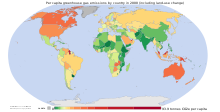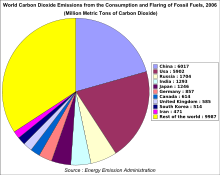Environmental issues in the United States
See also: Environment of the United States
As with many other countries there are a number of environmental issues in the United States.
Contents[hide] |
[edit]Issues
[edit]Climate change
Main article: Climate change in the United States
The United States is the second largest emitter, after China, of carbon dioxide from the burning of fossil fuels.[1] The energy policy of the United Statesis widely debated; many call on the country to take a leading role in fighting global warming.[2] The U.S. is one of only two countries that has not signed up to the Kyoto Protocol.
See also: Kyoto protocol#United States
[edit]Conservation
Main article: Conservation in the United States
Many plant and animal species became extinct soon after first human settlement, including the North American megafauna; others have become nearly extinct since European settlement, among them the American Bison and California Condor.[3]
The last of the passenger pigeons died in 1914 after being the most common bird in North America. They were killed as both a source of food and because they were a threat to farming. Saving the Bald Eagle, the national bird of the U.S., from extinction was a notable conservation success.
[edit]Deforestation
Main article: Deforestation in the United States
[edit]Energy
Main article: Energy in the United States
Since about 86% of all types of energy used in the United States are derived from fossil fuelconsumption it is closely linked to greenhouse gas emissions. The energy policy of the United States is determined by federal, state and local public entities, which address issues of energy production, distribution, and consumption, such as building codes and gas mileage standards.
[edit]Invasive species
Main article: Invasive species in the United States
Invasive species
[edit]Mining
Main article: Mining in the United States
[edit]Nuclear
The most notable accident involving nuclear power in the United States was the Three Mile Island accident in 1979. Davis-Besse Nuclear Power Station has been the source of two of the top five most dangerous nuclear incidents in the United States since 1979.[4]
Nuclear safety in the United States is governed by federal regulations and continues to be studied by the Nuclear Regulatory Commission (NRC). The safety of nuclear plants and materials controlled by the U.S. government for research and weapons production, as well those powering naval vessels, is not governed by the NRC.
The anti-nuclear movement in the United States consists of more than eighty anti-nuclear groups which have acted to oppose nuclear power and/ornuclear weapons in the USA. The movement has delayed construction or halted commitments to build some new nuclear plants,[5][6] and has pressured the Nuclear Regulatory Commission to enforce and strengthen the safety regulations for nuclear power plants.[7] Anti-nuclear campaigns that captured national public attention in the 1970s and 1980s involved the Calvert Cliffs Nuclear Power Plant, Seabrook Station Nuclear Power Plant,Diablo Canyon Power Plant, Shoreham Nuclear Power Plant, and Three Mile Island.[5]
[edit]Pesticides
Main article: Pesticide use in the United States
Pesticide use in the United States is predominately by the agricultural sector. and about a quarter of pesticides used are used in houses, yards, parks, golf courses, and swimming pools.[citation needed]
The Federal Insecticide, Fungicide, and Rodenticide Act (FIFRA) was first passed in 1947, giving the United States Department of Agriculture responsibility for regulating pesticides. In 1972, FIFRA underwent a major revision and transferred responsibility of pesticide regulation to the Environmental Protection Agency and shifted emphasis to protection of the environment and public health.
[edit]Pollution
Main article: Pollution in the United States
[edit]Air pollution
Main article: Air pollution in the United States
[edit]Water pollution
Main article: Water pollution in the United States
[edit]Marine pollution
See also: Cruise ship pollution in the United States and Regulation of ship pollution in the United States
[edit]Solid and hazardous waste
Main article: Hazardous waste in the United States
At 760 kg per person the United States generates the greatest amount of municipal waste.[8]
[edit]Population
Main article: Population of the United States
The total U.S. population crossed the 100 million mark around 1915, the 200 million mark in 1967, and the 300 million mark in 2006 (estimated on Tuesday, October 17).[9][10] The U.S. population more than tripled during the 20th century — a growth rate of about 1.3 percent a year — from about 76 million in 1900 to 281 million in 2000. This is unlike most European countries, especially Germany, Russia, Italy and Greece, whose populationsare slowly declining, and whose fertility rates are below replacement.
Population growth is fastest among minorities, and according to the United States Census Bureau's estimation for 2005, 45% of American children under the age of 5 are minorities.[11] In 2007, the nation’s minority population reached 102.5 million.[12] A year before, the minority population totaled 100.7 million. Hispanic and Latino Americans accounted for almost half (1.4 million) of the national population growth of 2.9 million between July 1, 2005, and July 1, 2006.[13]
Based on a population clock maintained by the U.S. Census Bureau, the current U.S. population, as of 5:55 GMT (EST+5) 27 April 2012 is 313,437,337.[14] A 2004 U.S. Census Bureau report predicted an increase of one third by the year 2050.[15] A subsequent 2008 report projects a population of 439 million, which is a 44% increase from 2008.
[edit]Waste
Main article: Waste in the United States
See also: Electronic waste in the United States
[edit]Environmental movement
Main article: Environmental movement in the United States
In the United States today, the organized environmental movement is represented by a wide range of organizations sometimes called non-governmental organizations or NGOs. These organizations exist on local national and international scales. Environmental NGOs vary widely in political views and in the amount they seek to influence the government. The environmental movement today consists of both large national groups and also many smaller local groups with local concerns. Some resemble the old U.S. conservation movement - whose modern expression is the Nature Conservancy, Audubon Society and National Geographic Society - American organizations with a worldwide influence.









0 comments:
Post a Comment